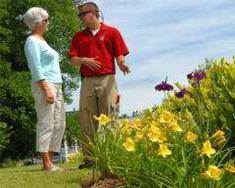Lawn Care
 May is a good month to repair your lawn. Fill in the bare spots by slightly loosening surface of the soil and sow a good quality lawn seed over the area evenly. Tamp the seed in gently and water. Keep the patch moist by covering with light mulch of lawn clippings. This is the time to eliminate lawn weeds by hand pulling, or the application of a ‘weed and feed’ fertilizer before they go to seed!
May is a good month to repair your lawn. Fill in the bare spots by slightly loosening surface of the soil and sow a good quality lawn seed over the area evenly. Tamp the seed in gently and water. Keep the patch moist by covering with light mulch of lawn clippings. This is the time to eliminate lawn weeds by hand pulling, or the application of a ‘weed and feed’ fertilizer before they go to seed!
Setting your mower for a higher cut during the spring months will help the grass to grow in fuller and help choke out the weeds.
This Page is about what’s new and what’s hot at Abbondanzo’s in the landscape industry and in your backyard!
Caring for Your Shrubs and Trees
It’s still not too late to fertilize your trees and shrubs. Use a Rhododendron or Evergreen type of plant food to feed evergreens and other acid loving plants like Azaleas and Rhododendrons, Camellias and Junipers, etc. Use an all-purpose garden fertilizer (10-10-10) to feed roses, deciduous shrubs and trees. Be sure to water the fertilizer in thoroughly after it is applied.
Early flowering deciduous shrubs such as Forsythias, Weigela, and Spirea should be pruned back when they have finished blooming. Cut back a third of the oldest canes to ground level, then cut back one third of the remaining branches by one third of their height.
Remove the wilting seed heads from Rhododendrons and Azaleas so that the plants energy can go to foliage growth and next year’s flowers, rather than seeds.
Work lime in the soil around your Hydrangeas to produce pink flowers or Aluminum Sulphate for blue blooms.
Remove any sucker growths from fruit trees as soon as they appear!
Keep a vigilante eye on the roses. Keep them sprayed for aphids and other pests and diseases such as black spot.
Pines and other conifers can be kept to a compact size by pinching off the new growth ‘candles’.
Lilacs should be pruned lightly after they finish blooming, removing sucker growths and dead blooms.
Feed lilacs in May with a good all-purpose 10-10-10 fertilizer after they have finished blooming. If your soil is acidic, work a little lime into the soil as well.
Caring for your Annuals, Perennials and Bulbs
Dahlias, Gladiolas, Lilies, Cannas and other summer flowering bulbs can be planted this month.
Gladiolas bulbs may be planted at 2 week increments until the first of July to provide you with cut flowers until the first frost.
Delphiniums, Phlox, Daylilies, Carnations, Aubrietia, Candytuft, Basket of Gold, Primroses, Coral Bells and Saxifrage and other summer flowering perennials may all be set into the garden any time in May.
Break off wilting Tulip or Daffodil heads but continue to feed and care for the plants until the foliage has died back naturally. Old plantings of Daffodils may be divided and moved when they have finished blooming, but treat them as growing plants and use care to protect the foliage and roots.
Water them thoroughly after transplanting.
It is best not to dig or move other spring flowering bulbs until their foliage has ripened and died back.
Pansies, Snapdragons, Dianthus, Petunias, Geraniums, Fuchsias and Impatiens should be ready to plant by mid-month. Toward the end of the month, it should be warm enough to plant out the more tender annuals like Salvia, Zinnias, Marigolds and Cardinal Flowers.
Lightly side dress perennials with an all-purpose 5-10-10 or 10-10-10 fertilizer. Avoid spilling the fertilizer on the plant, and use care not to damage the shallow roots when you cultivate it into the soil.
Setting the stakes next to your taller flowers early in the season, will help to support the plant against winds as well as making it easier to ‘train’.
Promptly remove spent flowers from any plant unless your intent is to harvest the seeds. It consumes the plants energy to produce the seeds, and in many species of plants, especially annual plants, removing the dead flowers will promote further blooms.
This month’s Specials!
**********************************
New Customer Bonus!
Call today for a FREE estmate!
Sign up for full service and get 10% off a fertilization program!
